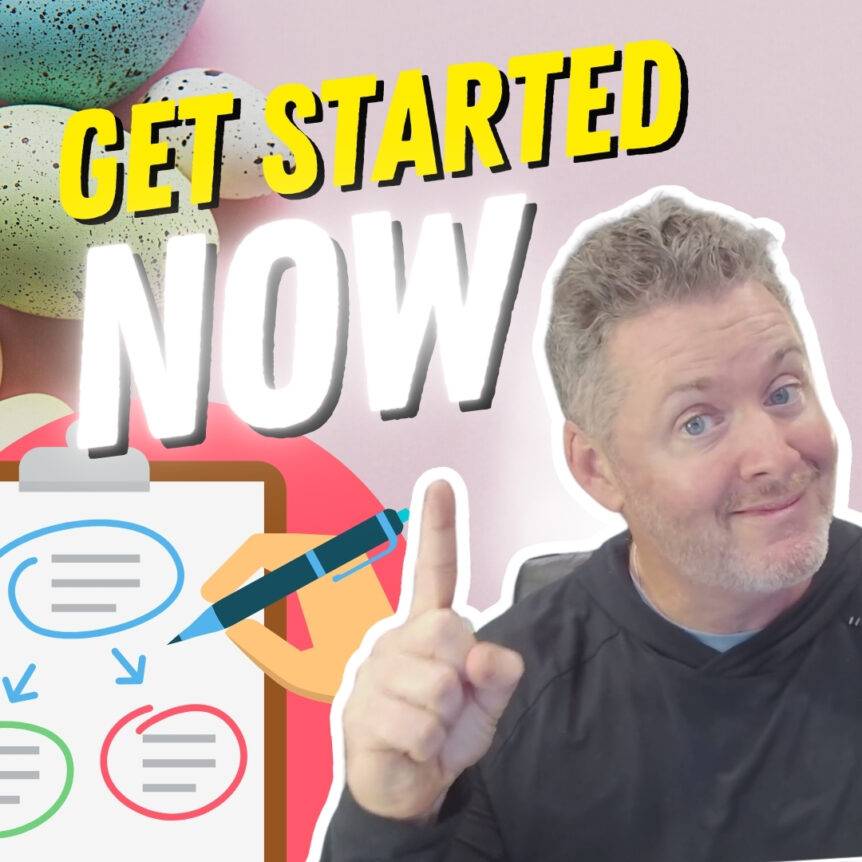As the joyous season of Easter approaches, churches around the world prepare to commemorate the pivotal event in our Christian faith: the resurrection of Jesus Christ. So how can we properly honor and host this important holiday? Easter service planning goes beyond logistical arrangements. It is a sacred endeavor aimed at facilitating profound spiritual experiences for Christians in your church.
The significance of Easter calls for meticulous attention to detail in crafting a service that resonates with the essence of the Christian message—redemption, hope, and renewal. From setting appropriate goals to choosing the right worship songs to crafting an impactful sermon, each element plays a vital role in conveying the meaning behind Easter Sunday.
This podcast is a comprehensive guide to aid pastors, church leaders, and volunteers in orchestrating an Easter service that not only honors the traditions of the faith but also invigorates hearts and minds with the transformative power of the Easter story.
Let’s jump in.
Estimated reading time: 11 minutes
Table of contents
Understanding Easter

Easter is a special time for Christians all around the world. It’s not just about chocolate eggs and bunnies; it’s about something much more important. Let’s explore why Easter is so significant.
Easter Sunday
Easter Sunday is the most important day in the Christian calendar. It’s the day when Christians celebrate Jesus rising from the dead after being crucified.
This event is called the resurrection, and it’s the cornerstone of the Christian faith. All of this together means that Easter Sunday is a day of great joy and hope for Christians everywhere.
Easter Services
Easter services are special gatherings that take place in churches on Easter Sunday and throughout the Easter season. These services are a time for Christians to come together to worship and celebrate the resurrection of Jesus.
During Easter services, people sing songs, listen to readings from the Bible, and hear sermons that remind them of the significance of Easter. Easter services help Christians remember the sacrifice Jesus made and the hope that his resurrection brings.
Easter Season
We have to remember that Easter isn’t just one day; it’s a whole season that lasts for several weeks. The Easter season begins on Easter Sunday and continues for 50 days until Pentecost Sunday. During this time, Christians reflect on the meaning of Jesus’ resurrection and what it means for their faith.
The Easter season is a time of renewal and new beginnings, as Christians are reminded of the hope and new life that Jesus’ resurrection brings.
Easter is a time of great importance for Christians around the world. Easter Sunday, Easter services, and the Easter season all play a part in helping Christians celebrate the resurrection of Jesus and the hope that it brings to their lives. It’s a time to come together, worship, and remember the incredible love that God has shown to humanity through Jesus Christ.
Planning Your Easter Sunday Service

Preparing for Easter is a special time for churches everywhere. As we’ve established, Easter is important to our faith, so we must honor it rightly.
Planning your Easter service can be exciting and fun, but also challenging. From setting goals to choosing music and organizing logistics, there’s a lot to think about. In this section, we’ll break down the steps to help you plan a successful Easter celebration that honors the significance of this special day in the Christian calendar.
Setting Goals
Before you start planning your Easter service, it’s important to think about what you want to achieve. Setting goals can help you stay focused and make sure your service is meaningful for everyone who attends.
Think about what message you want to share with your congregation. Do you want to focus on the hope and joy of Jesus’ resurrection? Or do you want to explore the themes of redemption and new life? Once you know what you want to say, you can start thinking about how to communicate that message through your service.
Another important goal to consider is how you want people to feel during and after the service. Do you want them to feel uplifted and inspired? Do you want them to feel connected to God and each other? Thinking about the emotional impact of your service can help you choose the right music, readings, and other elements to include.
Pre-Planning
Make an Easter planning checklist for the entire Easter service so that you can stay on top of things and make sure you accomplish your objectives. Throughout the entire planning process, you’ll want to make sure your entire team is communicating and adapting.
We would also suggest planning far in advance so that you can get invites out early. An Easter landing page on your church website is a great way for people to easily access the information about your Easter service. Advertise it on your social media platforms for even more reach!
According to Statistia, 51% of Americans visit church on Easter.

This means you will have to prepare to receive a lot more people than you normally would. Make sure you have enough room and resources to hold extra people that may show up.
Order of Service
Once you’ve set your goals, it’s time to plan the order of your Easter service. Start by thinking about the flow of the service and how each element will fit together to create a cohesive whole.
Begin with an opening that welcomes Easter guests to the service and sets the tone for what’s to come. This might include a greeting, a prayer, or a piece of music that helps people focus their hearts and minds on worship.
Next, think about how you want to incorporate music and worship into your service. Choose songs and hymns that reflect the themes of Easter and help people connect with God in a meaningful way. Consider including special music performances or choir numbers to add variety and interest to the service. We have more suggestions about music in the next step.
After the music, you might include readings from the Bible that tell the story of Jesus’ death and resurrection. These readings can help people understand the significance of Easter and its importance in the Christian faith.
The centerpiece of your Easter service will likely be the sermon or message. This is your opportunity to share the Easter story in a way that’s relevant and engaging for your congregation. Think about how you can bring the message of Easter to life through storytelling, personal anecdotes, and practical application. We’ll cover this in more detail in a later section.
Finally, end your service with a closing that sends people out with a sense of purpose and mission. This might include a final prayer, a blessing, or a commissioning that challenges people to live out the message of Easter in their daily lives.
Music and Worship
Music and worship play a central role in any Easter service. Choose songs and hymns that celebrate the resurrection of Jesus and help people connect with God in a meaningful way.
Consider the mood and tone you want to create with your music selections. Upbeat, joyful songs can help people celebrate the hope and victory of Easter, while quieter, reflective songs can create space for contemplation and prayer. Here are some worship song suggestions:
- “Alive” by Hillsong Young & Free
- “This is Amazing Grace” by Phil Wickham
- “Glorious Day” by Passion
- “Christ is Risen” by Matt Maher
- “Forever” by Kari Jobe
In addition to congregational singing, consider incorporating special music performances or choir numbers into your service. These can add variety and interest to the worship experience and help people engage with the message of Easter in a deeper way.
Logistics and Resources
Finally, don’t forget to think about the logistics and resources you’ll need to make your Easter service a success. This might include things like sound equipment, projection screens, and printed materials like bulletins or programs.
Make sure you have enough volunteers to help with things like greeting people at the door, leading worship, and running sound and multimedia during the service. Consider holding rehearsals in the weeks leading up to Easter to make sure everyone knows their roles and feels comfortable with the flow of the service.
Think about any special elements you want to include in your service, like baptisms or communion. Make sure you have everything you need to make those elements meaningful and impactful.
By setting goals, planning the order of your service, choosing music and worship elements, and thinking through logistics and resources, you can create a meaningful and memorable Easter service that helps people connect with God and celebrate the hope and joy of Jesus’ resurrection.
Crafting an Easter Sermon

Crafting an Easter sermon is a special opportunity to share the powerful message of Jesus’ resurrection with your congregation. Here are some key steps to help you create an impactful sermon that resonates with your audience.
Understanding the Message
Before you start crafting your sermon, take some time to reflect on the meaning of Easter and what it represents in the Christian faith. Easter is a time of hope, redemption, and new beginnings. It’s a reminder of God’s love for us and the victory of life over death.
As you prepare your sermon, think about how you can convey these themes in a way that speaks to the hearts of your listeners. Consider using stories, anecdotes, and personal experiences to illustrate the transformative power of Jesus’ resurrection and how it can bring hope and renewal to our lives.
Choosing Your Key Points
Once you have a clear understanding of the message you want to convey, think about the key points you want to emphasize in your sermon. What aspects of the Easter story do you want to highlight? What lessons or insights do you want your congregation to take away from your message?
Choose a few key points that resonate with the overarching theme of Easter and develop them into the central focus of your sermon. Keep your message simple and straightforward, and try to avoid overwhelming your audience with too much information.
Focus on communicating a few powerful ideas that will leave a lasting impression on your listeners.
Refining Your Delivery
Finally, consider how you will deliver your sermon to your congregation. Think about your tone, pacing, and body language, and consider how these elements can enhance the impact of your message.
Practice your sermon beforehand to ensure that you feel comfortable and confident delivering it. Remember to speak from the heart and allow your passion for the Easter message to shine through in your words.
By crafting a thoughtful and engaging sermon, you can help your congregation connect more deeply with the true meaning of Easter and experience the hope and joy that it brings.
Evaluation and Reflection

After your Easter service is over, it’s important to take some time for evaluation and reflection. This helps you understand what went well and what could be improved for next time.
Assessing Your Service
Post Easter, gather feedback from attendees and volunteers to see how they felt about the service. Ask questions like what they enjoyed most, what could have been better, and if the message resonated with them.
Take note of any technical issues or logistical challenges that arose during the service. Reflect on whether your goals for the service were met and if the message of Easter was effectively communicated to the congregation.
Learning and Growing
Use the feedback and reflections gathered to identify areas for improvement and growth. Celebrate the successes of your Easter service and acknowledge the hard work of everyone involved. Consider what changes or adjustments could be made to enhance future Easter services.
Use this opportunity to learn from the experience and apply those lessons to your planning process for next year’s Easter service. Remember, evaluation and reflection are key components of continual improvement and ensuring that your Easter services remain meaningful and impactful for years to come.
Easter Service Planning

In conclusion, planning an Easter service is a journey of faith and community. By setting clear goals, crafting a meaningful order of service, selecting appropriate music, and organizing logistics, you can create a memorable experience for everyone involved.
Remember to reflect on the message of Easter and its significance, and strive to communicate it in a way that resonates with your congregation. As you evaluate and learn from each service, you’ll grow in your ability to create impactful Easter celebrations year after year.
With dedication and heart, your Easter service can inspire hope, renewal, and joy in the lives of those who attend. God bless!
More Resources for Holidays





